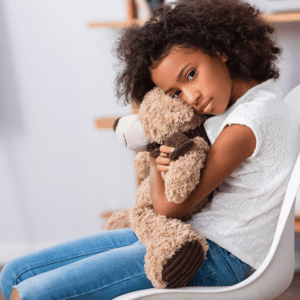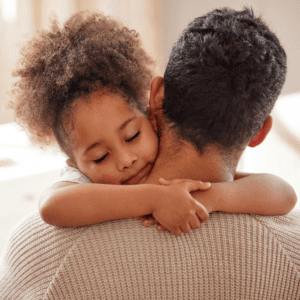How to talk to your child about the death of a loved one

The experience of losing a family member or pet can bring up challenging and complicated feelings and questions for the whole family.
In addition to their age, a child’s personality, relationships, and previous experiences can have a significant impact on their experience of death. Likewise, experiences of both grief and of healing will be strongly influenced by culture, religious or spiritual beliefs, and previous lived experiences. The following are some general best practices, but your family’s ways of grieving, healing, and supporting one another will be unique.
For most children and teenagers
When dealing with grief, most children and teenagers need:

To express their feelings, questions, and worries. Death can prompt new realizations and fears about life and loss, and children look to their trusted caregivers to help them understand this part of life and to get reassurance that they are safe. You can help them with this by validating their feelings and answering their questions nonjudgmentally. When you validate a child’s feelings, you are showing that you understand how they’re feeling, that you accept it as a legitimate way of feeling, and that you love them just the same. You may or may not share their same feeling; it’s not about having the same experience, but about accepting their experience. “I know that you’re really sad that Grandma died. I am too. What are you wondering about?” or “You seem to be really angry since we found out that Uncle Jerry died. That can happen when someone dies. Want to tell me about what you’re thinking about?”
Clear, honest language. Many cultures and families use euphemisms for dying like “passed on,” “lost,” “didn’t make it” or “went away.” For parents, this often comes from our wish to protect our children from pain. However, this kind of language can lead to more confusion or fear for children. Children might fear that sleep can cause death, for example, or wonder if friends who “go away” will die.

It is OK to tell a child or teen that someone died, and to use the word “death.” If they want to know more, explain it in language they can understand. For younger children, this might sound something like, “Pop-pop died because his body was very old and stopped working. Your body and my body are young, strong, and work really well.” For older children, you may choose to explain the basics of a diagnosis or illness like saying, “Rover had cancer. That means that he had cells growing where they weren’t supposed to be growing, and that stopped his body from working how it was supposed to.” Teenagers typically understand what death is and what can cause it, and will still benefit from being able to talk with you honestly about what happened. This might sound like, “Tina had alcoholism, and died because her liver failed. What questions do you have?”
To maintain routines as much as possible. When someone dies, it is normal and expected that your family’s daily routine might be interrupted. However, it can be helpful for children and teenagers to get back into a routine. Routines can be comforting to children because they know what to expect, and can feel a familiar sense of control over their activities and choices. When they’ve experienced a big change like a loss, this can make them feel safer. You’ll want to find the balance between honoring your family’s needs and feelings and maintaining a consistent rhythm. This might look something like going back to school and regular activities while carving time in the evenings and weekends to talk about how they’re feeling.

To honor and remember the loved one who died. Sometimes adults are uncomfortable talking to children about someone who has died because they fear it will make the child sadder. However, just as it can be healing for adults to honor loved ones, children also can experience healing when given the opportunity to remember their loved ones. This might look something like attending a funeral or memorial. If this isn’t possible or appropriate for your child, consider doing a family celebration of your loved one’s life in a way that makes sense for your children’s developmental age. It’s OK – and can be a good way of grieving – to share stories, look at photos, or draw pictures of your loved one.
Patience. Just as our adult experience of loss changes over time, children and teenagers will go through different phases of feelings, understandings, and acceptance after someone dies. You can help your child heal from and understand death by continuing to practice these strategies in the weeks, months, and years following your family’s loss.

By Age
A child’s developmental age influences their response to death. Understanding this can be helpful in understanding how best to support them, what behaviors are typical, and what behaviors may be cause for professional mental health intervention.
Under 4
Children under age 4 do not have an understanding of the permanence of death, but still may go through a grieving process. They may miss the person who has died, and they may also experience a change in their daily routines, notice that their family has changed, or react to seeing others’ response to the death.
You may notice:
Repeated questions. Young children want to know that they are safe, and asking the same questions over and over can be their way of trying to confirm that they are safe even while their family goes through a change and the adults are acting differently.
Regressive behavior. This refers to behaviors that are more typical of younger children. Children who are potty trained, for example, may have accidents. You may notice more tantrums, crying, clinginess, or “baby talk.” This may be a way for them to get more attention from you, which is a normal and healthy reaction to stress. When children (and adults!) are stressed, they are also less able to regulate themselves, leading to more emotional outbursts like tantrums or crying spells.
You can help by:
Being patient, reassuring, and loving. Remind yourself that your child’s behaviors come from being overwhelmed, confused, or scared and is not willful defiance or “bad behavior.” It is OK to give them extra comfort, attention, and cuddles during this time: you will not be “spoiling” or “weakening” them. You are teaching them that you will take care of them and love them even in difficult times.
Maintaining routine as much as possible. Routines help young children feel safe. As much as possible, keep your child on their regular mealtime, naptime, playtime, and bedtime schedule.
Answering their questions in simple, direct, and honest ways. Know that young children are egocentric, meaning that they assume that their experiences are everyone else’s experiences. This means that when someone dies, it is normal for young children to wonder about their own death (without really knowing what death means). You can reassure them that they are safe, healthy, and loved. For example, a conversation with a 4 year old might sound like:
Explaining death: “Aunt Lolly died, which means that her body stopped working. We won’t be able to see her again, and this makes our family really sad because we’ll miss her hugs and her cherry pies and playing Bingo with her. What do you remember about Aunt Lolly? Do you have any questions?”
Reassuring them: “Your body is strong and healthy and you won’t die for a long, long, long, long time. I plan to be alive for a long time too!”
Encouraging play as an outlet. Play is the way that children make sense of the world. Play has lots of benefits for young children, and during times of grief and loss, it can serve as their way of being able to control and understand something. It can also be fun, cathartic, and joyful, which is an important part of healing.
Ages 4-7
Children this age may still think of death as reversible. Even when they do know that death is permanent, they may use “magical thinking” to understand it. Magical thinking is when children assume that magic or another special force is responsible for something that happens. For example, only enjoying potatoes if they eat them with their red fork, or believing that their teddy bear keeps nightmares away. This is a normal, healthy phase of their social, emotional, and intellectual development.
Children this age may also use magical thinking to explain death. This may mean that a child believes that someone died because they were angry with them, or that their cat died because they didn’t let them sleep on their bed. It is important to explain death clearly and simply and reassure children that was not their fault.
You may notice:
Regressive behavior, or behavior that is more typical of younger children or that your child has grown out of. This may include bedwetting, tantrums, clinginess, or “baby talk.” This is a stress response: we are all less able to regulate our emotions when we are overwhelmed, and grief can be such an experience.
Changes in sleeping or eating. This is normal during periods of stress. As much as possible, keep your child on a regular routine to support getting back into healthy sleep and eating patterns.
Aggressive or violent play. Play is children’s way of making sense of the world, processing their emotions, and asserting some control when they feel they are powerless. It is normal – and can be healthy – for children to use play to express anger, rage, grief, and confusion. Seeking out and experiencing joy is a normal, acceptable, helpful part of healing from a loss.
You can help by:
Being patient, reassuring, and loving. Changes in behavior can be stressful for everyone, especially for a family also in mourning. Your child’s behaviors are likely a result of intense feelings of sadness, anger, confusion, or fear and are not willful defiance or “bad behavior.” By providing extra love and attention, you are teaching them that your love is consistent and unconditional and that you will be there for them when they are in pain.
Providing accurate, age-appropriate information. Answer their questions simply and honestly, and ask what other questions they have. You can follow their lead here – it is OK if they don’t want to talk much. You can let them know you’re available when they do want to talk.
Encouraging play, writing, and drawing. Play and creativity of all forms can help children (and adults) process their feelings.
Talking about your loved one. Sharing memories and looking at pictures can be a healing way to connect with family and friends.
Ages 8-13
Children this age usually understand that death is final, though they still may have questions about how death happens. They will have also moved past their egocentric phase and will be better able to understand others’ perspectives, so they will be more aware of how other people are responding to the loss. You do not need to hide your own grief – it is healthy for children to see adults feeling and processing their own emotions. Children should not be made responsible for caring for adults’ feelings, however, so be mindful of what you’re asking your preteen to support you through.
You may notice:
Regressive behavior, which is behavior that is more typical of younger children. This may include bedwetting, tantrums, emotional outbursts, fearfulness, or “baby talk.” This is a stress response: when we are stressed, we are less able to use our typical coping strategies and can be more easily overwhelmed. This is true for children this age during periods of grief.
Withdrawal from friends. Children this age may understand that not all other children have experienced death, and so may shy away from friends for a time while they process their feelings.
Changes in eating and sleeping. As much as possible, keep your child on a regular routine to support getting back into healthy sleep and eating patterns.
You can help by:
Validating their feelings. This involves acknowledging, accepting, and normalizing their feelings, even if you are having a different experience or if you know you can’t take away their pain. You may say things like, “I see that you’re really angry right now; it’s normal to feel that way. I’m here if you want to talk” or “This is really, really sad. Do you want a hug?”
Being available and respecting their need for alone time. Children may seek quiet time, and may also seek extra attention from you.
Ages 13 and up
Teenagers may feel a very wide, very intense range of emotions when grieving, and may not yet understand that this is a normal response to loss. You can support them by normalizing their experiences and being available and open.
You may notice:
Preference for spending time with friends over family. Friendships are incredibly important during the teenager years, and it is normal for your child to seek out their friends during difficult times.
Intense feelings and mood swings. Sadness, anger, denial, and irritability are normal responses to loss.
Increased risk-taking. Some teenagers will seek out risky activities when experiencing grief.
You can help by:
Validating their feelings and keeping communication open. This means acknowledging, accepting, and normalizing their feelings and questions. Help them understand that strong feelings can be confusing, but are a normal response to loss. Talk together about how you can help them safely navigate these feelings, and put in reasonable boundaries and safeguards.
Encouraging them to spend time with friends and loved ones. Routines, connecting with friends, and finding joy and escape can be helpful to healing. Help your child find a healthy balance between being with friends, being with family, and having alone time.
Helping them understand that grief is a journey, and there is no right or wrong way to grieve. They may always be sad about losing a loved one, but the intensity of their feelings, their available coping strategies, and their understanding of the loss will change over time.
Supporting a child through a significant loss can be incredibly difficult for parents, and can introduce a new dimension to mourning. Take care of yourself by reaching out for support from friends and family, engaging in activities that keep you grounded, and nourishing your body, mind, and spirit.
Grief can be a lifelong process, and will change over the days, months, and years after a loss. If your child’s response to a death makes you concerned for their safety, or if you or your child are struggling significantly for more than 6 months, talk to a doctor or a mental health professional. You or your child may benefit from additional support.
This project on Improving Mental, Behavioral and Academic Supports to Students and Families, Part 2 is supported by the Centers for Disease Control and Prevention of the U.S. Department of Health and Human Services (HHS) as part of a financial assistance award totaling $434,555 with 100 percent funded by CDC/HHS. The contents are those of the author(s) and do not necessarily represent the official views of, nor an endorsement, by CDC/HHS, or the U.S. Government.